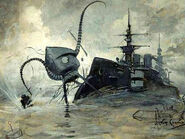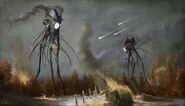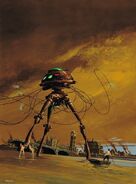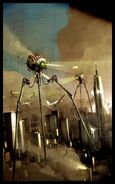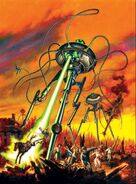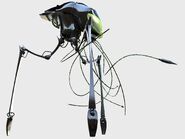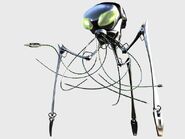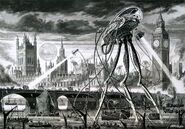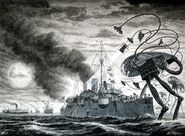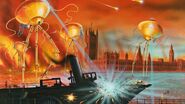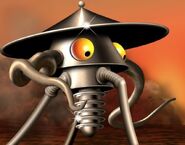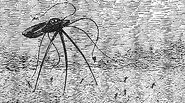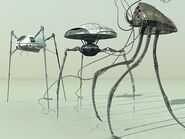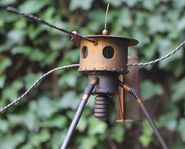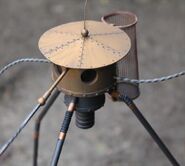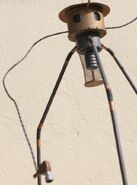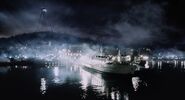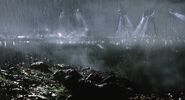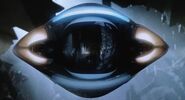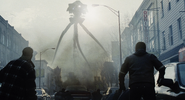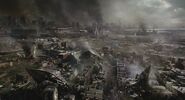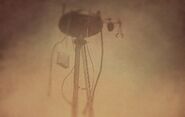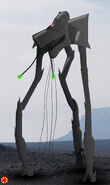The fighting machine, also known as a tripod and very rarely as a thing, is the main war machine used by the Martians in their attempt to conquer Earth.
Design and Function
The fighting-machines are assembled in the Martian pits by handling-machines before activation and each tripod possesses an unspecified number of tentacles, one of which can retract into the tripod when its primary weapon, the Heat-Ray, is not in use. The tentacles are also able to hold a Magnetic Acceleration Cannon. Tentacles were also used in the novel to pick up people, throw them at objects, and even rip up small trees, indicating a high degree of strength and precision.
The head is described as a "brazen" hood that holds the Martian pilot. Whether "brazen" here refers to the hood being made of a brass-like substance or its attitude is uncertain. The head can turn in any direction. The tripod as a whole appears as if it is made from a substance similar to aluminum.
The Martian tripod also is composed of a segment known as the "body", for which there are few details. The body apparently contains a jet, which can fire pressurized steam in order to dissipate black smoke. This steam is capable of breaking glass, and would surely cause a nasty burn, but is not shown in use as a weapon. There are also three legs. The novel never shows tripod legs being used to injure anyone directly, although this is a common occurrence in later works.
On the back of each tripod is what looks like a metal fishing basket, which it uses to hold humans that it captures with its tentacles.
The tripods in the original book could be destroyed by human weapons, usually artillery, although losses were usually heavier for the humans than the Martians. A number of later works assert that this is impossible.
According to one instance in the book, the machine gives off a howl that is given as "Aloo!" However, this should not be confused with "Ulla", a sound given off by the Martians themselves.
The assembly process of the fighting machines is somewhat uncertain. When the Martians first arrive at earth, they erect a device which functions like a heat ray to defend themselves. Later on, they are said to have moved in something like a large covered dish, which is probably the hood of a fighting machine, and some components of the vehicle itself not yet set up in a fully erect form.
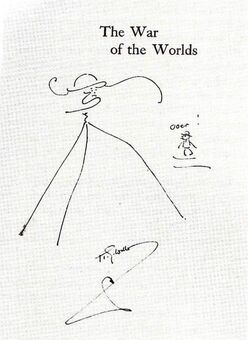
A Fighting machine drew by H. G. Wells himself
The Narrator discusses the fighting machines emitting a luminous green smoke from joints. A mechanical system which mimics the motions of muscles, and a number of sliding bearings are also mentioned as being integral to fighting machine technology. The devices also apparently contain large quantities of some brown fluid, which is seen to leak out when one is destroyed at Weybridge. This brown substance may turn a more reddish colour, and clump up while in water, but this is uncertain, as so many details in the novel are left slightly ambiguous.
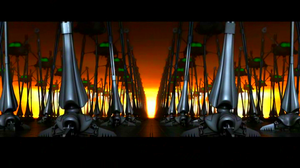
Fighting-Machines (Jeff Wayne's Musical Version of The War of the Worlds)
The Narrator describes the machine like a giant cow milking bench, rocking back and forth in its walk. London newspapers say the fighting machines were like ovens or stoves (depending on the translation) mounted on three legs, however, the narrator denies this by stating that no one has been as close to the Martians as he was, calling later illustrations of the Martians "not very precise".
Tripods In Other Media
In Film and TV adaptations, the tripods have seen many designs.
George Pál's The War of the Worlds
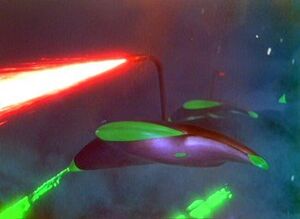
Martian Craft firing Heat Ray and Skeleton Beams.
The 1953 adaptation of The War of the Worlds by renowned sci-fi producer George Pál used models resembling manta rays topped with a heat-ray "swan-neck" to portray the fighting-machine, likely inspired by Well's description of the Flying-machines. Appropriately, these machines also hovered in the air like a spaceship. There were originally three electromagnetic legs, which can be seen early in the film and in the climax, but were discontinued during production, most likely because the producers deemed the one million volts needed to create the effect was too dangerous. Because of this it makes its legs invisible for most of the film proving it does not hover.
George Pal's machine had two different weapons, including two wingtip mounted "skeleton beams"(which replaced the black smoke from the novel) and a swan neck heat-ray. It also has a magnetic energy shield to protect the machine from enemy fire. This shield was powerful enough to withstand the effect of the atomic bomb.
Like Steven Spielberg's tripod design, George Pal's so-called manta-machine had a remotely operated "electronic eye" which was used to scout inside derelict buildings.
TV series
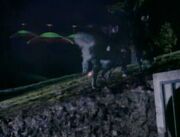
Tripods from War of the Worlds (TV Series)
The sequel to the 1953 film rarely uses war machines, but in respect to continuity, those seen are based on Albert Nozaki's design.
One episode ("Dust to Dust") does show a centuries-old variant of the manta-machine that does have physical legs for locomotion.
Steven Spielberg's War of The Worlds
The most recent film adaptation of War of the Worlds features a squid/jellyfish-like design for the tripod. For this design, it has two windshields that are on both sides of the dome like head, a dozen or more tentacles that can be
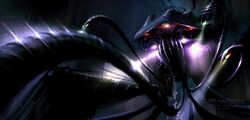
retracted, two heat rays (the heat rays themselves disintegrate any living organism, but leaves behind inanimate objects such as clothing), bendable legs which connect to the wrist or ankles of the tripod that have three fingers or toes, and three headlights on the front, with one massive headlight. In the movie itself, there has shown to be three different types of tripods, one of which lacks tentacles and instead only has heat rays, while the other has their tentacles deployed and visible cages on the under-behind of their hood, but with the third model shown later in the film as it has Four headlights along with the central massive headlight leading to the design of it more Heavy-duty as it used both tentacles and heat-rays.For each tentacle, it has at least one camera probe. Their horn is a deep-foghorn noise, similar to the "aloo!" of the book. Like the other adaptations, this tripod has an energy shield. It possessed two sprayers on its sides,
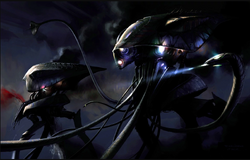
The tripods from Ryan Church's concept art for the 2005 movie.
which fertilize the surrounding area with red weed. Their walk was inspired by the red-eyed tree fog when it walks.
It is evidently taller than any other adaptation (150 feet tall to be exact), besides the 1953 designs of the war machine. In this adaptation, the tripods have been waiting beneath under the ground for countless years to be activated by the returning aliens.
However, it lacks one thing that is common in other models; the Black Smoke.
Jeff Wayne's The War of the Worlds
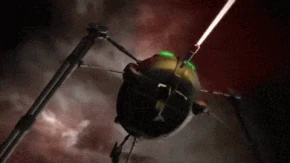
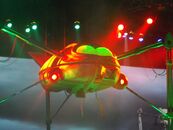
Tripods as Seen in Jeff Wayne's War of the Worlds, Live on Stage 2006.
Perhaps the most iconic version of the fighting-machine is the Jeff Wayne's Musical version of The War of the Worlds. This is the first tripod design not to include a storage basket (which was placed instead on the handling-machine).
It also does not appear to have tentacles, but the animation for the live tour of The War of the Worlds The New Generation shows them using tentacles in two scenes, one where it picks up a soldier and another where it carries the debris of a destroyed fighting machine. Its weapons include two black smoke launchers and one socket joined Heat-Ray in the cupola of the hood. It is also the most chunky and heavily armored design although because the cockpit is immobile, one would believe it to be it is less maneuverable. After the death of the Martians; a red synthetic is pulled out of the open hood by crows.
Pendragon Pictures' H.G. Wells' The War of the Worlds
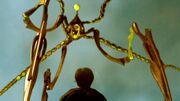
Pendragon's 2005 tripod.
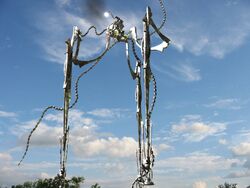
Pendragon's fighting-machines are silver, with a cockpit and a retractile Heat-Ray. It has four chain-link tentacles, 3 articulate legs and a basket for storing humans. Instead of emitting the famous "Ulla" cry, it screeches a high-pitched howl.
The Asylum productions War of the Worlds
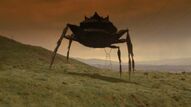
Asylum's War of the Worlds Walker
In H.G. Wells' War of the Worlds, a film adaptation from The Asylum productions, the fighting-machine is a walker, but not a tripod. Instead it has six legs, resembling a crab. The heat-ray is built into the body of the machine, shooting through a slot on its "head," which rotates like a turret. This machine can also eject an object that emits a green gas (a substance similar to the black smoke) through the same slot. It also has an opening atop the head through which Martians can leave the machine, as well at least one appendage that is depicted as grabbing fleeing humans.
In the Asylum's sequel War of the Worlds 2: The Next Wave the new walkers are tripods. Unlike the first film the Martians do not control the tripods from the inside but instead the tripods are living cyborg organisms controlled by a signal from a Mothership. They also have the ability to disappear.
Manga Gothic Media's "The War"

Unfinished Fighting Machine for MGM's "The War"
The Fighting Machine in the upcoming Open Movie "The War" is depicted as a predatory arachnid. It is deliberately designed so as not to incorporate the wheel (as the Martians showed no evidence as to utilizing it in their technology). It is made of an unknown metal and motivated by a metallic muscle and bone structure. They are in effect an extension of the Martian's will, highly flexible and agile. They are capable of great speed and large slow strides. Their joints also emit a greenish smoke (as depicted in the book) and they emit the sound "alloo" and "Ullah. They come with at least six tentacles of an unknown flexible metallic like material and the carry their heat-rays on a flexible antenna. The cage which holds captured creatures is located on their underbelly. They also come in several classifications. In the two films, "The Harvest" and the "Crystal Egg," a pre-war type, referred to as the scout or the hunter, is seen hunting down and harvesting the few surviving humans on the planet Mars.
The War of the Worlds: Goliath
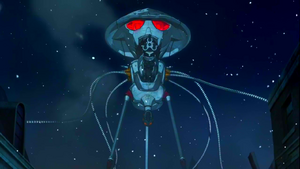
The first variant of the Martian Tripods in "The War of the Worlds: Goliath".
There are two variants of the Martian's tripods in WOTW:G. The first are seen at the beginning of the film in Leeds during the Martian's initial invasion in 1899 and are later seen in flashback when showing footage of London and other locations coming under attack. The tripods have a round 'cap' on the top of its head, while the head of the machine appears to resemble a face - having two large red eyes and an open section full of red tubes and a jagged edge that resembles a mouth; serving to give it a creepier design. This version has a trio of tentacles on each side with a sharpened point on each end, three spikes protruding out of its back and twin heat rays at the front. The smaller heat ray at the base between its legs and consists of two cannons that appear to be used for a quick strike attack, while the larger variant is on its front with a triple cannon that is used for firing a more powerful beam for a longer length of time. However, this variant apparently does not have the Black Smoke and - unlike other Fighting machines in other films/media - it does not have shields as a young Eric Wells was able to throw a rock at it, which bounced
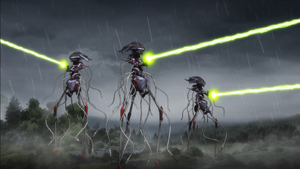
The War of the Worlds: Goliath - The Upgraded Fighting Machines.
harmlessly off it's leg. When the Martians fall after succumbing to Earth's bacteria, this variant of their fighting machine is recovered and studied by humanity - with its technology eventually reverse engineered by Professor Nikolai Tesla to create the various Tripods used by A.R.E.S.
The second variant appears during the Martian's second invasion attempt in 1914 and are based on H.G. Wells's version of a tripod.
It is bigger than many buildings and is both bigger and faster than the 1899 tripod variants, along with possessing more tentacles and more powerful heat rays than its predecessor. However, it still lacks both shields and the Black smoke.
The Great Martian War 1913-1917
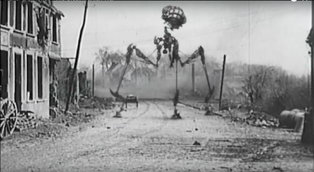
The Great Martian War Tripod
In this mockumentary of the story of the War of the Worlds, the tripods are described kind of like the ones in the book. They move similar to the movements of an insect. It can fire it's signature Heat Beam to melt objects or set them on fire. They also can move out tentacles that abduct or kill humans. They can come in different sizes. The large tripods are called Martian Herons and the smaller ones are called Martian Spiders. The spider, is kind of like the handling machine.
War of the Worlds: The True Story
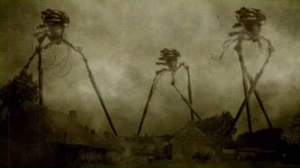
In this 2012 reboot of the story by Pendragon Pictures (who previously made the 2005 adaptation of The War of the Worlds), the Fighting Machines are brown, and they tower over 100 ft high. They can fire the signature heat ray, and black smoke. Though they are still vulnerable like the ones in the book, seeing as one was shot down. Still, they are so powerful, the humans who fight, are almost always literally wiped out. They are either killed, or abducted.
The War of the Worlds (TV Miniseries)
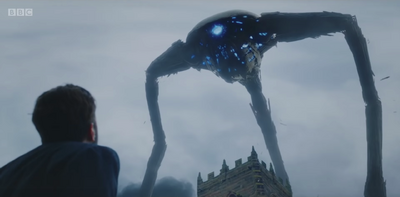
Tripod (BBC War of the Worlds)
In this version, tripods are built underground (presumably using terrestrial minerals) to create a machine with legs articulated in two sections. They have integrated the heat ray in the body itself that emits a blue light as if it were an eye. The characteristic <Aloo> is present, although in a more resounding way. They also have compartments at the bottom where they expel black smoke and, like the book, these can be destroyed but only by heavy artillery, such as the British naval guns themselves. Although difficult to see, in post production the mechanism by which the tripods work is appreciated, appreciating a biomechanical musculature that moves the plates of the machine to support, move, etc.
Trivia
- An earlier work by H.G. Wells, a short story known as The Crystal Egg, is set on Mars, and may actually refer to a fighting machine, or similar device in use on that planet.
- Alien tripod machines have been featured in many other media somewhat unrelated to The War of the Worlds novel, though they may still be inspired by H.G. Wells' tripods. Examples include the walkers from Chicken Little, the Walkers used by the Nexosporidium (Nexos) Warriors in Destroy All Humans! Path of the Furon and the tripodal walkers used by the Imperium in the animated series Justice League. The most notable, however, is John Christopher's 1967 Tripods trilogy.
Gallery
See also
External links

